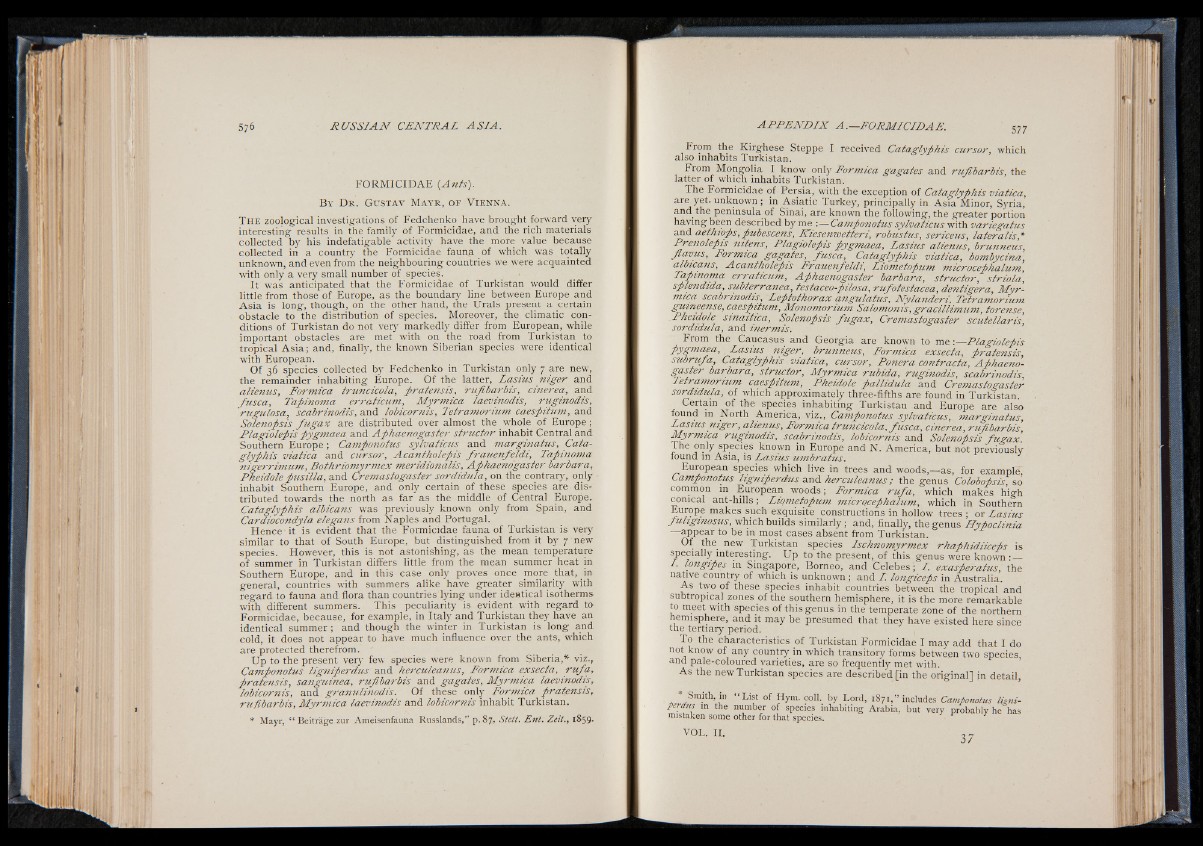
FORMICIDAE {Ants).
B y D r . G u s t a v M a y r , o f V i e n n a .
The zoological investigations of Fedchenko have brought forward very-
interesting results in the family of Formicidae, and the rich materials
collected by his indefatigable activity have the more value because
collected in a country the Formicidae fauna of which was totally
unknown, and even from the neighbouring countries we were acquainted
with only a very small number of species.
It was anticipated that the Formicidae of Turkistan would differ
little from those of Europe, as the boundary line between Europe and
Asia is long, though, on the other hand, the Urals present a certain
obstacle to the distribution of species. Moreover, the climatic conditions
of Turkistan do not very markedly differ from European, while
important obstacles are met with on the road from Turkistan to
tropical Asia; and, finally, the known Siberian species were identical
with European.
Of 36 species collected by Fedchenko in Turkistan only 7 are new,
the remainder inhabiting Europe. Of the latter, Lasius niger and
alienus, Formica truncicola, pratensis. rufibarbis, cinerea, and
fu sca , Tapihoma erraticum, Myrmica laevinodis, ruginodis,
rugulosa, scabrinodis, and lobicornis, Tetramorium caespitum, and
Solenopsis fu g a x are distributed over almost the whole of Europe ;
Plagiolepis pygmaea and Aphaenogaster structor inhabit Central and
Southern Europe; Camponotus sylvaticus and marginatus, Cataglyphis
viatica and cursor, Acantholepis fra uenfejd i, Tapinoma
nigerrimum, Bothriomyrme,x meridionalis, Aphaenogaster barbara,
Pheidole pusilla, and Cremastogaster sordidula, on the contrary, only
inhabit Southern Europe, and only certain of these species are distributed
towards the north as far as the middle of Central Europe.
Cataglyphis albicans was previously known only from Spain, and
Cardiocondyla elegans from Naples and Portugal.
Hence-it is evident that the Formicidae fauna of Turkistan is very
similar to that of South Europe, but distinguished from it by 7 new
species. However, this is not astonishing, as the mean temperature
of summer in Turkistan differs little from the mean summer heat in
Southern Europe, and in this case only proves once more that, in
general, countries with summers alike have greater similarity with
regard to fauna and flora than countries lying under identical isotherms
with different summers. This peculiarity is evident with regard to
Formicidae, because, for example, in Italy and Turkistan they have an
identical summer ; and though the winter in Turkistan is long and
cold, it does not appear to have much influence over the ants, which
are protected therefrom.
Up to the present very few species were known from Siberia,* viz.,
Camponotus lignipefdus and herculeanus, Formica exsecta, rufa,
pratensis, sanguinea, rufibarbis and gagates, Myrmica laevinodis,
lobicornis, and granulinodis. Of these only Formica pratensis,
rufibarbis, Myrmica laevinodis and lobicornis inhabit Turkistan.
* M a y r , “ B e i t r ä g e z u r A m e i s e n f a u n a R u s s l a n d s , ” p . 8 7 , Stett. E n t. Zeit., 1 8 5 9 .
From the Kirghese Steppe I received Cataglyphis cursor, which
also inhabits Turkistan.
From Mongolia I know only Formica gagates and rufibarbis, the
latter of which inhabits Turkistan.
The Formicidae of Persia, with the exception of Cataglyphis viatica,
are yet. unknown ; in Asiatic Turkey, principally in Asia Minor, Syria,
and the peninsula of Sinai, are known the following, the greater portion
having been described by me :— Camponotus sylvaticus with variegatus
and aethiops,pubescens, Kiesenwetteri, robustus, sericeus, lateralis,*
Prenolepis nitens, Plagiolepis pygmaea, Lasius alienus, brunneus,
fiavus, Formica gagates, fu sca, Cataglyphis viatica, bombycina,
albicans, Acantholepis Frauenfeldi, Liometopum microcephalum
Tapinoma erraticum, Aphaenogaster barbara, structor, striola,
splendida, subterranea, testaceo-pilosa, rufotestacea, dentigera, Myrmica
scabrinodis, Leptothorax angulatus, Nylanderi, Tetramorium
gumeense, caespitum, Monomorium Salomonis, gracillimum, torense,
Pheidole sinaitica, Solenopsis fu g a x , Cremastogaster scutellaris,
sordidula, and inermis.
From the Caucasus and Georgia are known to me:—Plagiolepis
pygmaea, Lasius niger, brunneus, Formica exsecta, pratensis,
subrufa, Cataglyphis viatica, cursor, Ponera contracta, Aphaenogaster
barbara, structor, Myrmica rubida, ruginodis, scabrinodis
Tetramorium caespitum, Pheidole pallidula and Cremastogaster
sordidula, of which approximately three-fifths are found in Turkistan.
Certain of the species inhabiting Turkistan and Europe are also
found in North America, viz., Camponotus sylvaticus, marginatus,
Lasius niger, alienus, Formica truncicola, fu sca , cinerea, rufibarbis
Myrmica ruginodis, scabrinodis, lobicornis and Solenopsis fu g a x .
The only species known in Europe and N. America, but not previously
found in Asia, is Lasius umbratus.
European species which live in trees and woods,—-as, for example’
Camponotus ligniperdus and herculeanus; the genus Colobopsis, so
common in European woods; Formica rufa, which makes high
conical ant-hills; Liometopum microcephalum, which in Southern
Europe makes such exquisite constructions in hollow trees ; or Lasius
fuhginosus, which builds similarly; and, finally, the genus Ilypoclinia
appear to be in most cases absent from Turkistan.
Of the new Turkistan species Ischnomyrmex rhaphidiiceps is
specially interesting. Up to the present, of this genus were known : —
/. longipes in Singapore, Borneo, and Celebes; I. exasperatus, the
native country of which is unknown ; and I. longiceps in Australia.
As two of these species inhabit countries between the tropical and
subtropical zones of the southern hemisphere, it is the more remarkable
to meet with species of this genus in the temperate zone of the northern
hemisphere, and it may be presumed that they have existed here since
the tertiary period.
To the characteristics of Turkistan Formicidae I mav add that I do
not know of any country in which transitory forms between two species
and pale-coloured varieties, are so frequently met with.
As the new Turkistan species are described [in the o r i g in a l ] jn detail,
Smith, in “ List of Hym. coll. by Lord, 1871,” includes Camponotus lieni-
perdus in the number of species inhabiting Arabia, but very probably he has
mistaken some other for that species.